Biryani! Biryani is a celebration of life itself. Find yourself in a funk? Start making biryani and I bet the multitude of flavors and aromas wafting through your house will uplift your senses and put a smile on your face.
OK. I’m only half kidding.
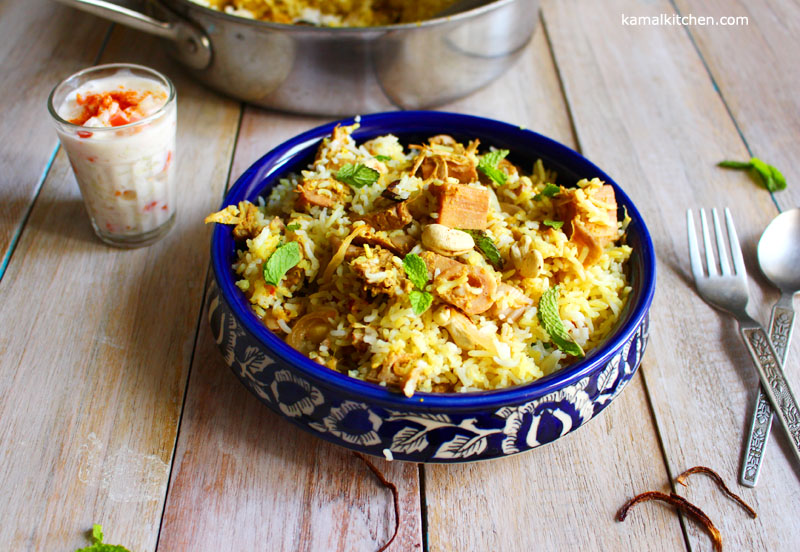
If you are new to Indian cooking, or a new cook, don’t fret. Biryani may be tedious and time consuming, but it is not difficult to make. All you need is some patience and some passion. Some good basmati rice and saffron. Some fried onions and nuts. Some vegetables like jackfruit. And plenty of ghee.
Vegetable biryani can be cooked in the ‘dum’ style. Sadly, it is really hard to find a good veggie biryani. Most people just fry veggies in masalas and toss them with rice, or overcook the veggies so much that all you have is mush.
A biryani is mildly spiced, aromatic and flavorful. It is not hot!
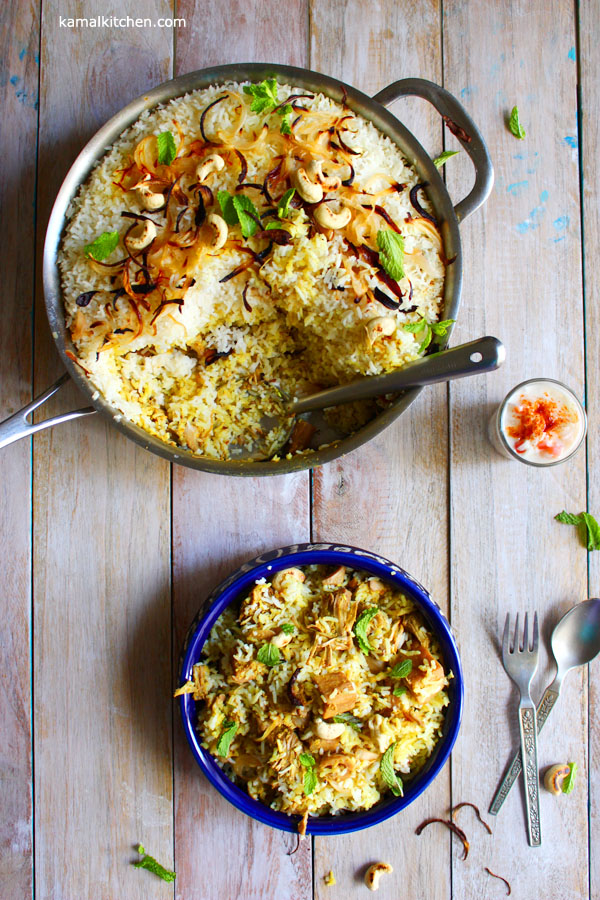
One of the basic rules of biryani are that the amount of rice should be equal to the amount of meat. This requires you to guess how much your rice will yield when cooked. In the case of meat based versions, your meat is going to double in amount after being cooked. The reverse is true of vegetables.
Vegetables cook down!
So say you want to end up with about 8 cups of Biryani. You need 4 cups cooked rice and 4 cups cooked veggies. This means you should start with about 2 cups of uncooked rice and 6-7 cups of raw veggies. Does that make sense.
I hope I’m not making this harder than it is?
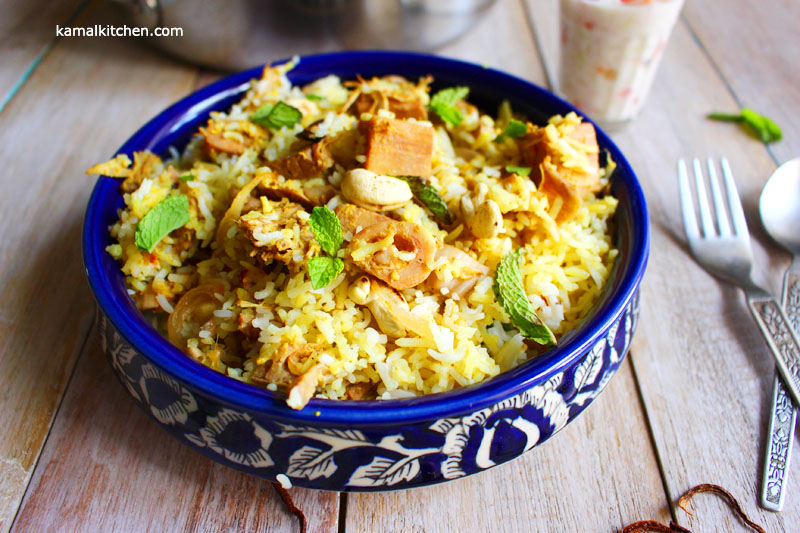
Jackfruit Biryani is a rare one. As I mentioned in my Jackfruit Curry post, jackfruit has a short season in the summer. The raw jackfruit has an even shorter season. But it makes an excellent biryani, mostly because of its meaty texture and the unique flavor.
You can use this method to make a biryani with mixed vegetables or mushrooms.
I started with cooked jackfruit. You can either do that or use raw jackfruit in the marination.
This recipe can be made vegan by ditching the ghee and leaving the curd out of the marination. But the ghee is the heart of the biryani. Just saying!
Fried onions are another aspect of the biryani I am always hesitant about. I don’t like buying the readymade fried onion. And I’m not really into a lot of deep frying myself. So I just toss the onions in some oil and slide it into the oven. So the texture and flavor are both not the same as fried onions, but they are close.
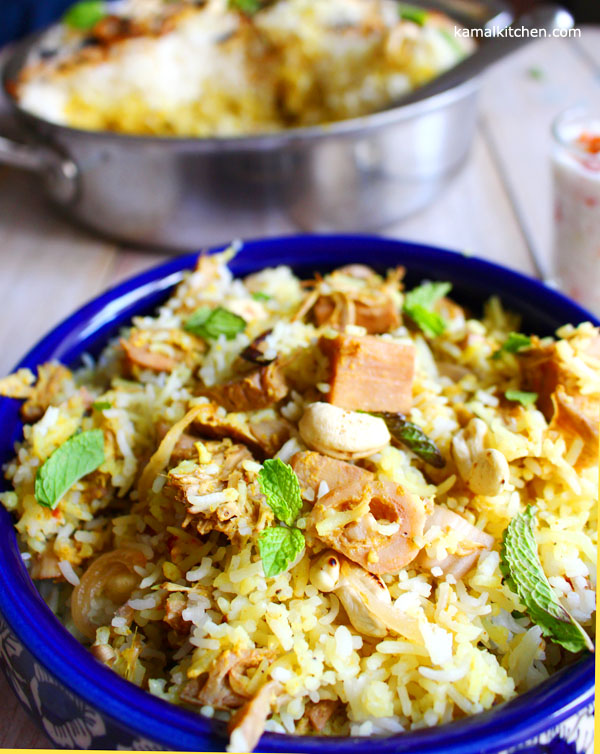
I am going to try and be as detailed as possible in the steps. Please feel free to ask for any more clarifications if needed.
Jackfruit Biryani – Summer Vegetable Biryani Recipe
Ingredients
- 4-6 cups onions, thinly sliced
- 4-5 cups jackfruit chunks
- 1-2 medium potatoes (optional)
- 2 Tbsp garlic, crushed
- 2 Tbsp ginger, grated
- 1 tsp coriander, ground
- ½ tsp red chili powder or paprika
- ½ tsp garam masala
- ½ tsp cumin, ground
- 1 cup thick yogurt
- 10-12 mint leaves
- 1 Tbsp ghee
- 2 medium onions, chopped
- 1 Tbsp ginger, chopped
- 1 Tbsp garlic, chopped
- 1 tomato, chopped
- 2 cups aged basmati rice
- 2-3 cloves
- 1 inch cinnamon stick
- 4 green cardamom pods
- 1 bay leaf
- 2 Tbsp ghee
- 2 cups water
- Salt to taste
- 1-2 pinch saffron
- ¼ cup milk
- ¼ cup roasted cashews
- more ghee
Method
- Mix all marinade ingredients together. add the jackfruit chunks and potatoes to this. Refrigerate for a few hours or overnight.
- Deep fry the onion until brown and crispy. Drain on paper towels and set aside.
- Blend all ingredients for spice paste to get a smooth paste without too much water.
- Add saffron to ¼ cup of warm milk and set aside to bloom.
- Heat 2 Tbsp of ghee in a pan. Add the whole spices and let them pop. Lower heat and add the rice.
- Fry rice until toasty.
- Add the water (1:1 of rice).
- Add salt and bring the rice to a boil. Lower heat and cover. Switch off heat when all water is absorbed. Rice will continue to cook on residual heat. Do not lift the lid for 10-15 minutes. This rice is going to be al dente and that is how we want it.
- Heat 2-3 Tbsp ghee/ oil in a large pan. Add the spice paste and fry until aromatic and cooked through, about 10-15 minutes.
- Add the marinated veggies.
- Cover and cook until the jackfruit is tender. In case of mixed veggies, cook until veggies are tender crisp. There should be some slurry or liquor in the pot at this time, but not so much that the veggies are floating in it.
- Now you can use the same vessel or start with a fresh pot to assemble the biryani. Let’s consider a fresh pot.
- Add half the rice in the pot.
- Sprinkle some fried onion on this rice.
- Pour in the veggies and their curry/ juice on top of this rice.
- Sprinkle some more fried onion on top.
- Add the remaining rice on top.
- Now pour the saffron/ milk mixture in a circle over the rice. Add any remaining fried onion and roasted cashews.
- Press everything down with a spatula. Pour a cup of water along the sides.
- Dot with some more ghee on top.
- Close with a tight lid and cook on a very low flame for 15-20 minutes until the lid is steamy and the aroma of the biryani infuses the air.
- Serve biryani with raita and more ghee.
- Note – Insert a spatula vertically in the biryani to check it is not burning at the bottom.
- Before switching off, check that all the water has cooked out.
- The level of the Biryani will rise a bit in the pot as the rice cooks and fluffs up more in the 15-20 minutes.
Are you still wary of trying your hand at Biryani? Don’t be. Use the same method given here to make any variation of biryani such as Potato Biryai, Paneer Biryani etc.
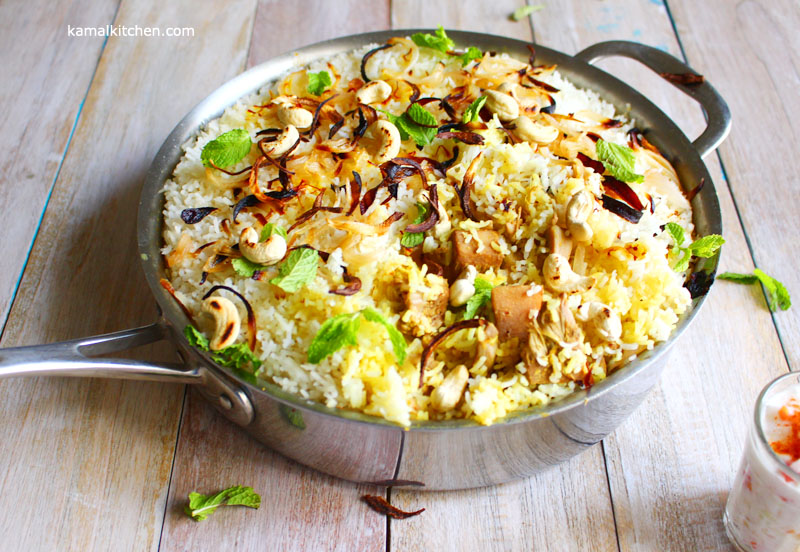
Leave a Reply